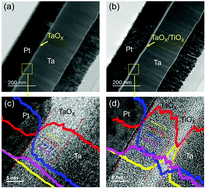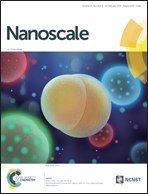Thin TiOx layer as a voltage divider layer located at the quasi-Ohmic junction in the Pt/Ta2O5/Ta resistance switching memory†
Abstract
Ta2O5 has been an appealing contender for the resistance switching random access memory (ReRAM). The resistance switching (RS) in this material is induced by the repeated formation and rupture of the conducting filaments (CFs) in the oxide layer, which are accompanied by the almost inevitable randomness of the switching parameters. In this work, a 1 to 2 nm-thick Ti layer was deposited on the 10 nm-thick Ta2O5 RS layer, which greatly improved the RS performances, including the much-improved switching uniformity. The Ti metal layer was naturally oxidized to TiOx (x < 2) and played the role of a series resistor, whose resistance value was comparable to the on-state resistance of the Ta2O5 RS layer. The series resistor TiOx efficiently suppressed the adverse effects of the voltage (or current) overshooting at the moment of switching by the appropriate voltage partake effect, which increased the controllability of the CF formation and rupture. The switching cycle endurance was increased by two orders of magnitude even during the severe current–voltage sweep tests compared with the samples without the thin TiOx layer. The Ti deposition did not induce any significant overhead to the fabrication process, making the process highly promising for the mass production of a reliable ReRAM.



 Please wait while we load your content...
Please wait while we load your content...